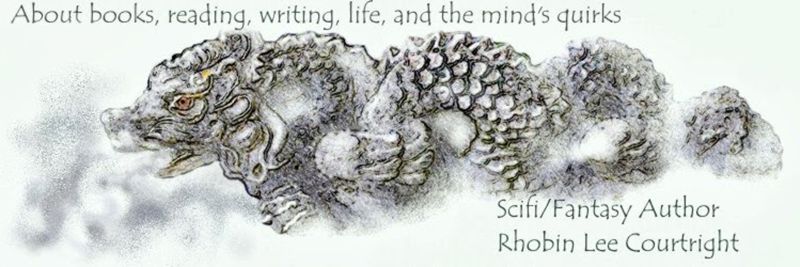I usually write science fiction or fantasy but have delved into historical and contemporary romance, and while I read those genres, I more often read other genres. Mysteries, adventure and suspense in their many varieties, Regency romances plus other historical and contemporary romances. And that's just in fiction. My non-fiction books are those I save, so I have a very large library of art, art history, crafts, general reference, history, writing, environment and nature, and both food and pleasure gardening books. Heck. that last type gives me sadness. I just discovered a day ago that for the first time since starting my pleasure gardens, deer have eaten all the Hosta in my garden. Their beautiful leaves of a few days ago are sad stalks. That aside, I think reading develops writers.
I don't think I can write the mysteries I love to read, and maybe that's a good thing. As a writer, I can be very critical of another scifi author's craft technique in my own genre, especially when it interrupts my reading. Sometimes I can ignore it and just enjoy the story; sometimes I can't and it ends my reading. Which might be why I enjoy mystery and suspense so much. I used to love Regency romances because I loved the authors Jane Austen and Georgette Heyer and the dance of manners their stories presented. Recently stories set in this era and the Victorian era have changed drastically to become more sex-oriented. I still read it. Of course, mysteries have always crossed over into many genres, including historical romance, which I enjoy.
Like every other reader, I read for certain reasons, and certainly entertainment is the first that comes to mind, which brings relaxation. Yet, giving the mind a new experience also plays into my reading and this plays into both fiction and nonfiction reading. In nonfiction, of course, I seeking information and to learn something about a topic that interests me. In fiction, no matter what the genre, I'm always fascinated at how reading words can meld into an imagination-based reality.
Please visit these authors to explore this topic:
Skye Taylor
A.J. Maguire
Anne de Gruchy
Heather Haven
Dr. Bob Rich
Helena Fairfax
Fiona McGier
Kay Sisk
Rachael Kosinski
Connie Vines
I don't think I can write the mysteries I love to read, and maybe that's a good thing. As a writer, I can be very critical of another scifi author's craft technique in my own genre, especially when it interrupts my reading. Sometimes I can ignore it and just enjoy the story; sometimes I can't and it ends my reading. Which might be why I enjoy mystery and suspense so much. I used to love Regency romances because I loved the authors Jane Austen and Georgette Heyer and the dance of manners their stories presented. Recently stories set in this era and the Victorian era have changed drastically to become more sex-oriented. I still read it. Of course, mysteries have always crossed over into many genres, including historical romance, which I enjoy.
Like every other reader, I read for certain reasons, and certainly entertainment is the first that comes to mind, which brings relaxation. Yet, giving the mind a new experience also plays into my reading and this plays into both fiction and nonfiction reading. In nonfiction, of course, I seeking information and to learn something about a topic that interests me. In fiction, no matter what the genre, I'm always fascinated at how reading words can meld into an imagination-based reality.
Please visit these authors to explore this topic:
Skye Taylor
A.J. Maguire
Anne de Gruchy
Heather Haven
Dr. Bob Rich
Helena Fairfax
Fiona McGier
Kay Sisk
Rachael Kosinski
Connie Vines


